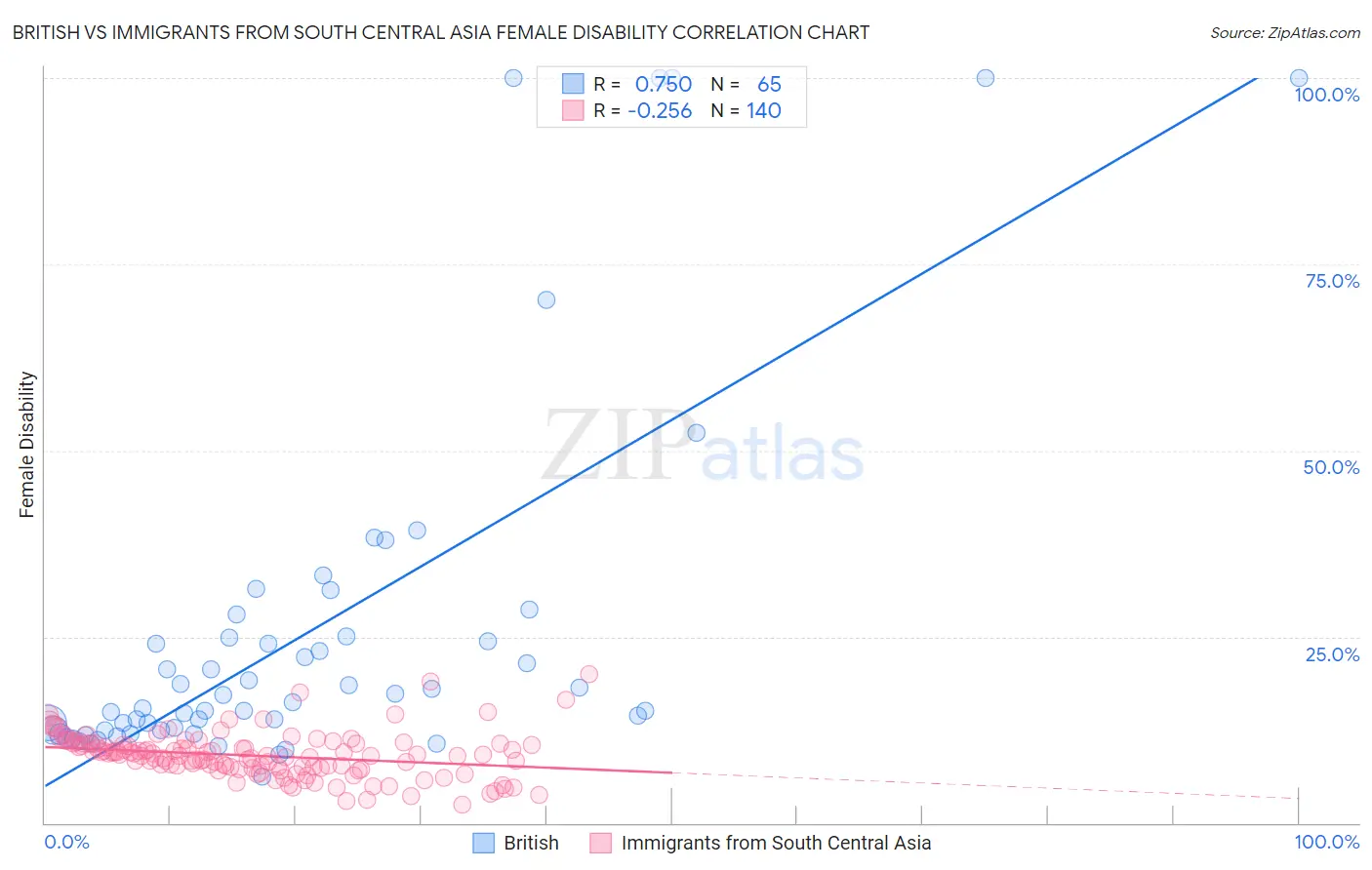British vs Immigrants from South Central Asia Female Disability
COMPARE
British
Immigrants from South Central Asia
Female Disability
Female Disability Comparison
British
Immigrants from South Central Asia
12.4%
FEMALE DISABILITY
12.7/ 100
METRIC RATING
217th/ 347
METRIC RANK
10.5%
FEMALE DISABILITY
100.0/ 100
METRIC RATING
8th/ 347
METRIC RANK
British vs Immigrants from South Central Asia Female Disability Correlation Chart
The statistical analysis conducted on geographies consisting of 531,338,456 people shows a strong positive correlation between the proportion of British and percentage of females with a disability in the United States with a correlation coefficient (R) of 0.750 and weighted average of 12.4%. Similarly, the statistical analysis conducted on geographies consisting of 473,039,804 people shows a weak negative correlation between the proportion of Immigrants from South Central Asia and percentage of females with a disability in the United States with a correlation coefficient (R) of -0.256 and weighted average of 10.5%, a difference of 18.7%.

Female Disability Correlation Summary
| Measurement | British | Immigrants from South Central Asia |
| Minimum | 6.2% | 2.5% |
| Maximum | 100.0% | 20.0% |
| Range | 93.8% | 17.5% |
| Mean | 25.6% | 9.0% |
| Median | 16.2% | 9.0% |
| Interquartile 25% (IQ1) | 12.4% | 7.5% |
| Interquartile 75% (IQ3) | 25.0% | 10.6% |
| Interquartile Range (IQR) | 12.6% | 3.2% |
| Standard Deviation (Sample) | 24.1% | 3.0% |
| Standard Deviation (Population) | 23.9% | 3.0% |
Similar Demographics by Female Disability
Demographics Similar to British by Female Disability
In terms of female disability, the demographic groups most similar to British are Immigrants from Bahamas (12.4%, a difference of 0.020%), Immigrants from Burma/Myanmar (12.4%, a difference of 0.050%), European (12.4%, a difference of 0.050%), Panamanian (12.4%, a difference of 0.060%), and Samoan (12.4%, a difference of 0.060%).
| Demographics | Rating | Rank | Female Disability |
| Swiss | 14.9 /100 | #210 | Poor 12.4% |
| Immigrants | Bosnia and Herzegovina | 14.8 /100 | #211 | Poor 12.4% |
| Ute | 14.7 /100 | #212 | Poor 12.4% |
| Immigrants | Thailand | 14.5 /100 | #213 | Poor 12.4% |
| Panamanians | 13.5 /100 | #214 | Poor 12.4% |
| Samoans | 13.4 /100 | #215 | Poor 12.4% |
| Immigrants | Burma/Myanmar | 13.3 /100 | #216 | Poor 12.4% |
| British | 12.7 /100 | #217 | Poor 12.4% |
| Immigrants | Bahamas | 12.5 /100 | #218 | Poor 12.4% |
| Europeans | 12.1 /100 | #219 | Poor 12.4% |
| Bahamians | 11.1 /100 | #220 | Poor 12.4% |
| Native Hawaiians | 10.8 /100 | #221 | Poor 12.4% |
| Italians | 10.7 /100 | #222 | Poor 12.4% |
| Guamanians/Chamorros | 9.5 /100 | #223 | Tragic 12.5% |
| Belizeans | 9.3 /100 | #224 | Tragic 12.5% |
Demographics Similar to Immigrants from South Central Asia by Female Disability
In terms of female disability, the demographic groups most similar to Immigrants from South Central Asia are Immigrants from Singapore (10.4%, a difference of 0.22%), Iranian (10.6%, a difference of 0.91%), Bolivian (10.4%, a difference of 1.0%), Immigrants from Hong Kong (10.6%, a difference of 1.6%), and Immigrants from Korea (10.6%, a difference of 1.7%).
| Demographics | Rating | Rank | Female Disability |
| Immigrants | India | 100.0 /100 | #1 | Exceptional 10.0% |
| Filipinos | 100.0 /100 | #2 | Exceptional 10.1% |
| Immigrants | Taiwan | 100.0 /100 | #3 | Exceptional 10.1% |
| Thais | 100.0 /100 | #4 | Exceptional 10.2% |
| Immigrants | Bolivia | 100.0 /100 | #5 | Exceptional 10.3% |
| Bolivians | 100.0 /100 | #6 | Exceptional 10.4% |
| Immigrants | Singapore | 100.0 /100 | #7 | Exceptional 10.4% |
| Immigrants | South Central Asia | 100.0 /100 | #8 | Exceptional 10.5% |
| Iranians | 100.0 /100 | #9 | Exceptional 10.6% |
| Immigrants | Hong Kong | 100.0 /100 | #10 | Exceptional 10.6% |
| Immigrants | Korea | 100.0 /100 | #11 | Exceptional 10.6% |
| Immigrants | Israel | 100.0 /100 | #12 | Exceptional 10.7% |
| Immigrants | Eastern Asia | 100.0 /100 | #13 | Exceptional 10.7% |
| Immigrants | China | 100.0 /100 | #14 | Exceptional 10.7% |
| Burmese | 100.0 /100 | #15 | Exceptional 10.7% |